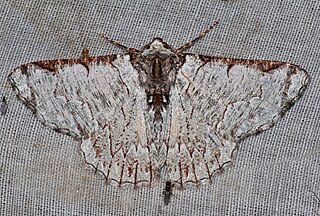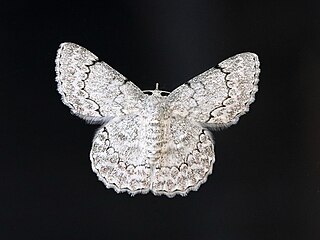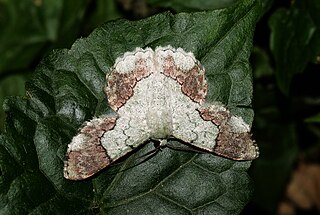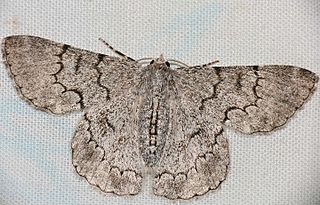
Hypodoxa is a genus of moths in the family Geometridae described by Prout in 1912.

Lophophelma is a genus of moths in the family Geometridae described by Prout in 1912.

Pingasa is a genus of moths in the family Geometridae first described by Frederic Moore in 1887.

Pingasa chlora, the white looper moth or flower-eating caterpillar, is a species of moth of the family Geometridae first described by Caspar Stoll in 1782. It is found Sundaland, the Philippines, Sulawesi and from the Moluccas to Queensland, Australia.

Pingasa rubicunda is a species of moth of the family Geometridae first described by William Warren in 1894. It is found in northern India, Sundaland and the Philippines.

Pingasa ruginaria is a species of moth of the family Geometridae first described by Achille Guenée in 1857. It is found in northern India, south-east Asia, the Ryukyu Islands and Sundaland.
The Pseudoterpnini are a tribe of geometer moths in the subfamily Geometrinae. The tribe was described by Warren in 1893. It was alternatively treated as subtribe Pseudoterpniti by Jeremy Daniel Holloway in 1996.

Pingasa hypoleucaria is a species of moth of the family Geometridae first described by Achille Guenée in 1862. It is found on Réunion and Mauritius.
Pingasa abyssiniaria is a moth of the family Geometridae first described by Achille Guenée in 1858. It is found in Ethiopia and South Africa.

Pingasa alba is a moth of the family Geometridae first described by Charles Swinhoe in 1891. It is found in the Chinese provinces of Hubei, Hunan, Guangxi, Zhejiang, Yunnan, Fujian, Guizhou, Jiangxi and Sichuan, and in Taiwan and Japan.

Pingasa angulifera is a moth of the family Geometridae first described by William Warren in 1896. It is found in Queensland, Australia.
Pingasa cinerea, the tan-spotted grey, is a moth of the family Geometridae. The species was first described by William Warren in 1894. It is found in the Australian states of New South Wales, Queensland, Tasmania and Victoria.
Pingasa decristata is a moth of the family Geometridae first described by William Warren in 1902. It occurs on São Tomé Island.
Pingasa dispensata is a moth of the family Geometridae first described by Francis Walker in 1860. It is found in India, Sulawesi and Africa.
Pingasa javensis is a moth of the family Geometridae first described by William Warren in 1894. It is found on Java.
Pingasa meeki is a moth of the family Geometridae first described by William Warren in 1907. It is found on New Guinea.

Pingasa rhadamaria is a moth of the family Geometridae first described by Achille Guenée in 1858. It is found on the Comoros, Madagascar and São Tomé and Príncipe and in Sierra Leone, South Africa, the Gambia, Zimbabwe, Cameroon, Ghana, Ethiopia, Kenya, Tanzania and Zambia.

Pingasa rubimontana is a moth of the family Geometridae first described by Jeremy Daniel Holloway and Manfred D. Sommerer in 1984. It is found on Sumatra, Borneo and Sulawesi. The habitat consists of upper montane forest, where it is found at elevations between 1,200 and 1,790 meters.
Pingasa subviridis is a moth of the family Geometridae first described by William Warren in 1896. It is found in India on Peninsular Malaysia, Sumatra, Java and Borneo. The habitat consists of forested lowland areas up to 1,930 meters.
Pingasa venusta is a moth of the family Geometridae first described by William Warren in 1894. It is found in the north-eastern Himalayas, Sundaland and on Sulawesi, Seram and on New Guinea. The habitat consists of lowland areas up to 1,930 meters, including disturbed vegetation and secondary forests.










